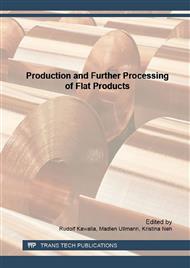p.200
p.207
p.215
p.225
p.231
p.237
p.243
p.249
p.255
Numerical Investigation of a Process Control for the Roller Levelling Process Based on a Force Measurement
Abstract:
When processing conventional semi-finished metal strips, distinctive changes in the material properties along the strip length are unavoidable. The roller levelling process is sensitive to changes of those strip characteristics. Thus, a process control allowing for an online adaption of the roller levelling machine according to the actual strip characteristics is highly desirable. In order to enable a precise process layout, the calculation by the Finite Element Method (FEM) provides a suited strategy. Furthermore, the coupling of user-subroutines to an FE code offers the possibility to implement and test respective control strategies. This work proposes a control strategy that is based on a force measurement in the first load triangle of a levelling machine. A first FE model including a feedback control is used to calculate the dependence between the force in the first load triangle and the roll intermesh in the last load triangle leading to a flat sheet. The results are transferred to meta models – so called control curves – that give a direct relationship between the measured force and the roll intermesh. Within a second FE setup a feed-forward control based on these control curves is implemented and the proposed control strategy is investigated for varying yield strengths along the strip length. Thus, the time consuming FE simulations that are necessary to obtain the control curves are decoupled from the actual levelling process. According to the obtained results, the introduced approach is able to improve the sheet flatness for thin sheets when a change in the material properties occurs.
Info:
Periodical:
Pages:
249-254
Citation:
Online since:
May 2016
Authors:
Permissions:
Share:
Citation:


